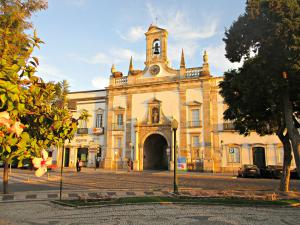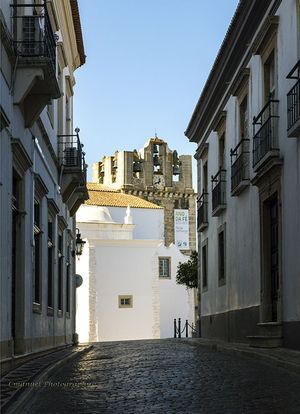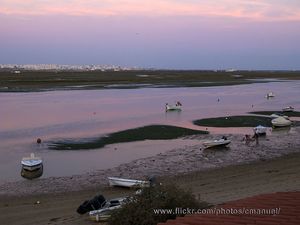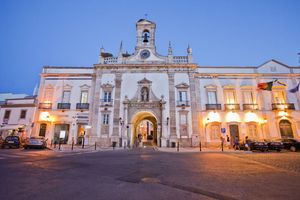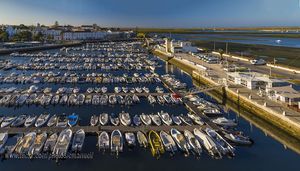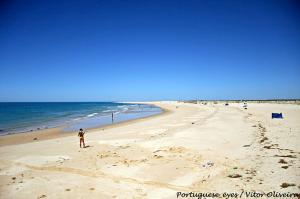
Faro, Portugal
Visit Faro, the beautiful capital of the Algarve region of Portugal, and discover its monuments and beaches
Faro is the beautiful capital city of the Algarve region in southern Portugal. Its ancient walls house a wonderful historic centre that will awe you with the beauty of its cobblestone streets and many impressive monuments. Outside the walls, you will find a more modern urban centre with large squares, pedestrian shopping streets, and a variety of bars and restaurants. As if that were not enough, the city is close to the majestic Ria Formosa Nature Reserve as well as some of the best beaches in Portugal.
Faro’s historic centre, known as the Cidade Velha (Old City), is undoubtedly the city’s main attraction. Throughout its beautiful, narrow, cobblestone streets, you’ll find the city’s most iconic monuments: the Faro Cathedral, or Sé de Faro, built in the 13th century in Gothic style; the Convento de Nossa Senhora da Assunção, a Renaissance-style building that houses the interesting Municipal Museum of Faro; the Arco da Vila, a beautiful entrance to the old town, built in the Neoclassical style and of Moorish origin; and the Nossa Senhora do Carmo Church, a charming Baroque church that houses the Capela dos Ossos, one of the most striking buildings in the city as it is built with the bones of ancient monks.
Near the historic centre, you’ll find the modern city centre. There, you can stroll through large squares and modern pedestrian shopping streets and enjoy numerous bars and restaurants. In the modern centre, you’ll find the famous Jardim Manuel Bívar. The beautiful garden is located near the port pier and has all kinds of trees and plants that will provide you with beautiful views. It is a very quiet and beautiful place, ideal to stop and rest during your visit to the streets of Faro.
Near Faro, there are three islands that give you the opportunity to enjoy the best beaches of the Algarve region: Ilha de Faro, Ilha Deserta, and Ilha da Culatra. To get to Ilha de Faro, you can go by car or by bus, but to get to the other islands, you have to travel by boat from the Faro pier. On the islands, you’ll discover tranquil beaches where you can relax as you sunbathe, go for a swim, or take a walk down the long stretches of fine golden sand.
Between Faro and the beaches is the Ria Formosa Nature Reserve. It is a beautiful natural park known for its iconic sand dunes. It also has interesting fauna and flora, including a wide variety of migratory birds as well as the famous seahorses.
In addition to seeing the sights, Faro also has plenty of activities for visitors to enjoy. The most popular activities are: golf, as Faro has one of the best golf resorts in the country; surfing, as the beaches of the Algarve are perfect for riding the waves; and hiking, as the area has good green routes to travel. Party-goers will also find Faro a good place to have a good time, as the city has numerous nightclubs and nightlife venues for partying.
Don’t miss the opportunity to enjoy the typical food of the area during your visit. In Faro, you will find bars and restaurants where you can taste the best Algarvian food. The most popular dishes are fish and seafood, especially octopus and the traditional seafood cataplana. Traditional dishes also include all kinds of grilled meats and enticing homemade desserts, such as the delicious orange cake.
Index:
- What are the best places to see in Faro, Portugal?
- What are the best things to do in Faro?
- What are the best excursions from Faro?
- When is the best time to visit Faro?
- What is the best way to get to Faro?
- Where are the best places to stay in Faro?
What are the best places to see in Faro, Portugal?
The highlight of Faro is the Cidade Velha, the city’s beautiful old town. Inside the mediaeval walls and among the beautiful cobblestone streets, you will find all kinds of monuments that will grab your attention.
As you enter the historic centre, your first pleasant surprise will be the Arco da Vila. The monumental archway is the most beautiful entrance to the centre of the city. It consists of a Renaissance-style Moorish portal that is decorated inside with a niche with the image of St. Thomas Aquinas.
Another busy entrance to the centre is the Arco do Repouso, an arch of Arab origin. It gets its name from being the place where King D. Alfonso IV stopped to rest and listen to music after taking the city.
Within the old town, one of the most emblematic monuments of the city is the cathedral, known as the Sé de Faro. It was built in the mid-thirteenth century in the Gothic style and has been transformed into a mix of various architectural styles. The biggest draw is the interior, where you will see the altarpiece, the choir section, and the cathedral’s spectacular chapels.
In the same square as the cathedral stands the Paço Episcopal (Episcopal Palace). Built in the early 17th century, the most impressive feature of this monument is the amazing set of Baroque and Rococo azulejos tiles inside.
Very close to both monuments, at the back of the cathedral, is the Convento de Nossa Senhora da Assunção, considered by many to be the most valuable building in the city of Faro. It is an Order of Saint Clare convent built in the 16th century in Renaissance style, with a Manueline church and a Baroque vault. It has been declared a national monument and now houses the Municipal Museum. The museum contains the spectacular Mosaic of the Ocean God, which dates back to the third century.
Another must-see is the Nossa Senhora do Carmo Church. The 18th-century Baroque building will dazzle you not only with its monumental facade with twin bell towers, but also with its interior. There, you'll find the decorated main altar covered in gold leaf, an image that will stay with you long after your visit. The church also has the well-known Capela dos Ossos, a somewhat macabre chapel covered with the bones of more than a thousand monks.
The historic centre is home to many other monuments worth visiting. Among them are: the Church of São Pedro, a 16th-century construction with a beautiful Renaissance portico; the Ermida de Nossa Senhora da Esperança shrine, from the 15th century; and the Lethes Theatre, a beautiful 17th-century building where you can enjoy the best shows.
The more modern part of the city also has storied buildings that will surprise you, above all: the Santo Antonio Church, where you can enjoy the beauty of the 15th-century building as well as the spectacular views from its mediaeval tower; the Jewish Cemetery, with marble tombstones and a synagogue; the Quinta da Horta do Ourives, a pretty 17th-century house; and the Casa das Figuras, a nobleman’s house transformed into a luxurious apartment.
In addition to the monuments, the urban centre has wide plazas, modern pedestrian shopping streets, and shops, bars, and restaurants. The most well-known places are the Manuel Bívar Gardens, a beautiful, lush garden near the pier, and Rua de Santo Antônio, a street with the most popular stores where you can pick up a souvenir of your visit to Faro.
In the city you will also find all kinds of museums. The most interesting include: the aforementioned Municipal Museum, located inside the Nossa Senhora da Assunção Convent and holder of the spectacular Mosaic of the Ocean God; the Regional Museum of the Algarve, where you will learn in depth about the traditional life of this area; the Almirante Ramalho Ortigão Maritime Museum, dedicated to the marine life of the Algarve and the oldest museum in the region; and the Algarve Living Science Centre, dedicated to exploring science and technology with attractive interactive exhibits.
Outside of the city, you’ll find the marvellous beaches of the Ilha de Faro, the Ilha Deserta, and the Ilha da Culatra islands. The islands have beaches with extensive golden sand, ideal for sunbathing or strolling, as well as crystalline waters that will entice you to go for a swim.
Near the beaches is the Ria Formosa Nature Reserve, a beautiful natural park with iconic sand dunes. The park has interesting wildlife, especially migratory birds and a large number of seahorses. It’s a good place to go for a boat or kayak ride or hike along its green trails.
What are the best things to do in Faro?
The main plan in Faro is to wander around both its wonderful old town, the Cidade Velha, and its modern city centre. Strolling between its ancient walls and through its cobblestone streets, you will see a huge number of historical monuments. Walking through the more modern area, you’ll find wide squares and pedestrian streets with stores, bars, and restaurants.
The most important monuments of the historic centre are: the Sé de Faro, a Gothic cathedral built in the 13th century; the Convento de Nossa Senhora da Assunção, a Renaissance-style convent that houses the interesting Municipal Museum of Faro; the Arco da Vila, a beautiful Renaissance-style Moorish archway; and the Nossa Senhora do Carmo Church, a charming Baroque church. The Nossa Senhora do Carmo Church houses the Capela dos Ossos, one of the most surprising buildings in the city; it is built with the bones of ancient monks.
Outside of the historic centre, in the modern urban centre, you’ll also find many places that are worth visiting. The Santo Antonio Church, the Jewish Cemetery, the Quinta da Horta do Ourives, and the Casa das Figuras are only a few of the most interesting sites. You should also visit the Jardim Manuel Bívar, a beautiful garden right by the pier with a variety of plants, and Rua San Antônio, a pedestrian shopping street with popular stores where you can buy a souvenir of your time in Faro.
If you are looking for a more cultural visit, you’re in luck. The city has several museums, among them: the Municipal Museum, which is located inside the Convento de Nossa Senhora da Assunção and has the spectacular Mosaic of the Ocean God; the Algarve Regional Museum, where you can discover what traditional life was like in the region; the Almirante Ramalho Ortigão Maritime Museum, the oldest museum in the Algarve, which is dedicated to marine life in the area; and the Algarve Living Science Centre, where you can learn about science and technology and have fun with attractive interactive exhibits.
Those who prefer to relax on the beach can't miss the opportunity to visit the warm sands of Ilha de Faro, Ilha Deserta, and Ilha da Culatra. On the islands, you’ll discover tranquil beaches where you can relax as you sunbathe, go for a refreshing swim, or take a walk down the long stretches of fine golden sand.
Near the beaches, you will also find the Ria Formosa Natural Reserve, an idyllic place for nature lovers. You will see the sand dunes, an icon of this natural park, as well as the varied fauna and flora typical of the area, like a multitude of migratory birds and fantastic seahorses. Touring the park by boat is a great way to explore the area from the water and contemplate all its beauty.
In Faro, you also have the opportunity to do all kinds of activities. The most popular are: golf, as the city has one of the best golf resorts in Portugal; surfing, because the beaches of the Algarve are ideal for catching waves; and hiking, because in the area you will find plenty of good green routes to travel. Party and nightlife lovers will also find Faro a good place to have a good time, as the city has many nightclubs and nightlife places to party.
Regardless of the plan you choose, you can’t miss out on trying some of the many bars and restaurants in Faro, where you will enjoy the best food in the Algarve. You must try popular fish and seafood dishes, especially the octopus and the traditional seafood cataplana. Traditional dishes also include many grilled meats and exquisite homemade desserts, like the delicious orange cake.
What are the best excursions from Faro?
The best day trip you can do from Faro is to Estoi. The small town is just 10 kilometres to the north, so you can get there easily by car or by one of the inexpensive buses that leave from Faro. The town’s main attraction is the Estoi Palace, a spectacular pink rococo palace with beautiful gardens and impressive azulejos tile murals.
The other great attraction in Estoi is the site of the ruins of the Roman Villa of Milreu. The best-preserved Roman remains in the Algarve, they date back to the 1st century and include numerous ancient mosaics. In addition to the palace and ruins, Estoi is worth visiting for other buildings in the city centre, such as the Igreja Matriz de Estoi, as well as for the centuries-old streets of the historic centre itself.
Also close to Faro, 10 kilometres to the east, is Olhão, a beautiful fishing village with the largest port in the Algarve. You will be fascinated by the streets of its historic centre and its iconic fishermen's quarter, which are perfect for a stroll. It is also close to the islands of Culatra and Armona, which have some of the best beaches in Europe.
A bit farther away from Faro, about half an hour by car, is Tavira, a beautiful, calm traditional fishing village. The city has a lovely fishing port and amazing buildings, such as its mediaeval castle and the Igreja de Santa Maria do Castelo. Near the city, you’ll find magnificent beaches of fine white sand and crystal-clear waters where you can relax like never before. In addition, Tavira is an ideal place to eat. You have to try its best dishes, especially the exquisite sardine pâté.
Moving to the west, just over half an hour's drive away, you will find Albufeira, one of the most visited towns in the Algarve. There, you can marvel at its beautiful historic centre and, above all, its heavenly beaches of fine white sand and crystal-clear waters. Albufeira is also known for having the best nightlife in Portugal, which you will find in the lively Strip district.
A little farther away, about 60 kilometres away, you can visit the Benagil and Carvoeiro caves. They are very close to each other and are true gems of the Algarve. To visit them, you should drive to both towns and explore the stunning interior of the grottoes and sea caves by boat. It’s a spectacular landscape that is sure to amaze you.
The city of Portimão is just a short distance from the caves. It is a beautiful fishing town that will draw you in with its beautiful old town and stunning beaches. Its streets hide true treasures such as the Jardim 1º Dezembro gardens, the Igreja de Nossa Senhora da Conceição Church, and the Praça da República square. The city is also home to the Ribeirinha, a great seaside promenade, and Praia da Rocha, one of the most beautiful beaches in the Algarve.
Just an hour's drive away, very close to the town of Lagoa, you’ll find Praia da Marinha. The emblem of the Algarve, Praia da Marinha is one of the most famous beaches in Portugal. You’ll find the high-quality waters and fabulous cliffs that earned the beach recognition from the Michelin Guide, which named it one of the 10 best beaches in Europe and one of the 100 best in the world.
A bit farther away, almost an hour and a half's drive from Faro, is Sagres, the southwesternmost point in Europe. The main icon of the city is its huge fortress, which is open to visitors. Sagres is known for its very calm atmosphere as well as for its great offering of sports such as surfing, climbing, and hiking, thanks to its fantastic natural environment.
When is the best time to visit Faro?
The best time to visit Faro is during the summer months. Between June and August, the temperatures are at their highest, and it's a great time to enjoy the beaches and all kinds of outdoor activities such as surfing, hiking, and climbing. Summer is also the liveliest time in the city, as this is when there are usually the most shows and events.
However, spring and autumn are still great times to visit the city. The weather is still pleasant, meaning wandering around and visiting the city is still a lovely experience. In fact, as walking is the recommended plan for visitors and the city is emptier during spring and autumn, you can wander the streets with greater peace of mind, and usually for a lower price.
The winter weather is not as pleasant, but temperatures are not too cold, hovering around 15 degrees Celsius. This means that plans such as going to the beach or doing certain outdoor activities are not recommended, but you can still walk the streets of the city. Above all, it is a perfect time to visit the various museums in Faro. It is also the time of year when accommodations and hotels tend to have the lowest prices.
Other interesting dates to visit Faro are during the International Music Festival of the Algarve, usually held between April and June, and during FolkFaro, a large folk festival with numerous shows and dances held towards the end of August. You can also visit during the Feira de Santa Iria, which is held towards the end of October. It is one of Faro's most important traditional festivals, honouring Saint Irene with all kinds of fairground attractions, stalls, and various shows.
What is the best way to get to Faro?
The best way to reach Faro from a distance is by plane. Faro has an international airport, the third most important in Portugal, so it receives flights from a large number of countries. It is also served by flights from Lisbon and Porto, making travel to Faro by plane extremely convenient.
Once you arrive at the airport, you’ll make your way into the city. To do so, you can take the bus (line 16) to the bus station in the centre. The only inconvenience with the bus is that it only passes every 30 to 40 minutes. If you’d like to get to the centre more quickly, you also have the option of booking a transfer at Faro Airport.
If you’re coming from the south of Spain, the region closest to the Algarve, the best way to travel is by car. You’ll have to take the A-49 from Seville in the direction of Huelva. When you reach the border with Portugal, take the A-22 until you reach the turn towards Faro. If you’re coming from the north of Spain, the fastest way to travel is by finding a direct flight. You could also take a train to Seville and continue to Faro from there.
Where are the best places to stay in Faro?
Faro has a wide range of accommodation options to suit your needs, from the most luxurious hotels to basic flats. The vast majority of them are concentrated in the areas between the marina, the old town, and the train station.
One of the best hotels is the Luxury Guest House Opus One. It is a 4-star hotel with a bar, a garden, an outdoor swimming pool, a shared lounge, a hot tub, a car rental service, and an airport shuttle. Its rooms have free wifi, TVs, air conditioning, wardrobes, and private bathrooms. In addition, it is located in the historic centre of Faro, making it the ideal hotel if you are looking for a centrally located hotel full of amenities.
Another similar hotel is the AP Eva Senses Hotel, a 4-star hotel that overlooks the marina from the middle of the historic centre of Faro. The hotel has a sauna, a Turkish bath, a swimming pool, and a spa, as well as a restaurant with stunning panoramic views of the city. It offers an airport shuttle service, free wifi, and a buffet breakfast. The hotel is a favourite of those looking for a great place to relax after a long day of sightseeing or sunbathing on the beach.
The Hotel Faro, a 4-star hotel in the heart of the city centre with sea views, is one of the hotels preferred by families. The hotel offers flat-screen TVs, free wifi, air conditioning, and minibars in the rooms, as well as parking, a swimming pool, a gym, and an included breakfast. The hotel's central location offers wonderful views of the city.
Equally central, just 20 metres from Calle San Antonio, but slightly cheaper, is the Stay Hotel Faro Centro. The 3-star hotel offers guests the essentials, such as air-conditioned rooms with free wifi and balconies, as well as an included breakfast, a bar, and guest parking. The Stay Hotel is a good choice if you are looking for a comfortable place with basic amenities but not too much luxury.
If you prefer flats to hotels, you’re in luck! Faro also has a large number of flats available for visitors. The two most notable are Happy House and Casas Adentro. They are very well kept flats and much cheaper than most hotels in Faro. They are double or single rooms with televisions, free wifi, and the appliances you’ll need to live comfortably during your visit. They also offer parking for guests and an airport shuttle service. They are also extremely central, which makes them ideal for staying in the heart of the city centre at reasonable prices.
Recommended Excursions:
Mapa Interactivo:
Faro
What to see:
- Cathedral of Faro
- Museu Municipal de Faro (Faro City Museum)
- Centro de Ciência Viva (Science Museum)
- Igreja da Misericórdia Church
- Algarve Regional Museum
- Almirante Ramalho Ortigão Maritime Museum
- Igreja de São Pedro Church
- Igreja de Nossa Senhora do Carmo Church and Capela dos Ossos Bone Chapel
- Lethes Theatre
- Santo António do Alto Church and Viewpoint
- Ermida de Nossa Senhora da Esperança Shrine
- Trem Gallery of Municipal Art
- Igreja de São Francisco Church
- Faro Jewish Heritage Museum
- Ría Formosa Natural Park
- Milreu Roman Site
Beaches:
Other worth-visiting nearby towns and cities:
Why "Portugal Travel"?
Portugal Travel is an organization of Portuguese agencies whose objectives are:
- ✓ To make Portugal, its culture and its heritage known.
- ✓ To promote sustainable tourism.
In collaboration with:
Escola Superior de Hotelaria e Turismo do Estoril
Turismo de Portugal
Copyright PortugalTravel.org © - All rights reserved.




